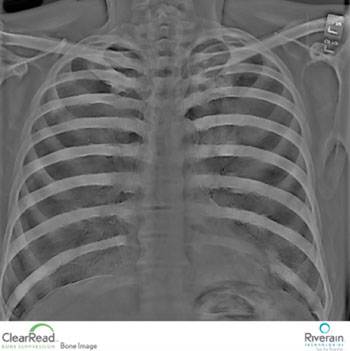Bone Suppression Software Used to Optimize Diagnostic Capability of X-Ray Systems
By MedImaging International staff writers
Posted on 18 Aug 2014
Clinicians are gathering important information from the most routine imaging exam, the chest X-ray, by using advanced software that enhances X-ray images captured by the equipment they already have or are in the process of buying. New bone suppression technology helps radiologists identify lung nodules and other serious medical conditions by converting a traditional chest X-ray into a soft tissue image without the ribs and clavicle bones. Posted on 18 Aug 2014
These structures typically obscure abnormalities. There are no further testing or radiation exposure for patients, and no need for imaging units or hardware for the hospital to buy or house to achieve the soft tissue image.

Image: An X-ray using the ClearRead bone suppression software technology (Photo courtesy of Riverain Technologies).
Riverain Technologies (Dayton, OH, USA) revenues increased 34% year-over-year through the first half of 2014 based on strong adoption of the company’s ClearRead software solutions. This was particularly true among academic medical centers and community and Veterans Administration (VA) hospitals throughout the US Midwest. “Most of the growth in adoption is being driven by radiologists’ recognition that bone suppression is very useful and there’s little to no downside to it,” said Heber MacMahon, MB, BCh, professor of radiology and director of thoracic imaging at the University of Chicago Medical Center (IL, USA).
In the past, no-bone, soft tissue images were only made possible by exposing patients to higher radiation levels using costly imaging equipment. The enhancements in clarity and performance of the X-ray are advantageous for patients because that X-ray is the most readily available and widely used imaging modality. Many lung tumors are first targeted on X-ray images taken for other reasons, such as to diagnose other medical conditions, including heart problems, broken ribs, collapsed lung, pneumonia, and emphysema.
“It’s nice to get more out of what we deliver,” said Ella Kazerooni, MD, past president of the Society of Thoracic Radiology, and professor and director, division cardiothoracic radiology, and associate chair for clinical affairs at the University of Michigan (U-M) Health System (Ann Arbor, USA). “The software is easy to install, easy to train to, and, frankly it provides immediate clinical value.”
The software is sold directly to medical centers, to enhance X-ray images captured by the machines they already have, and by major manufacturers including Siemens Healthcare (Erlangen, Germany) and Philips Healthcare (Best, The Netherlands) as a value-added extension to new X-ray equipment.
University of Chicago (IL, USA) bought ClearRead software after serving as a research site and validating the effectiveness of Riverain’s ClearRead bone suppression and computer-aided diagnosis (CAD) software, ClearRead +Detect, in improving the diagnostic potential of traditional X-ray images. “As long as we’re going to continue to do millions of chest X-rays around the world, with this software we’re going to pick up more cancers sooner and we’re going to miss less cancers,” said Dr. MacMahon, who is a member of Riverain’s medical advisory board.
In addition to purchasing ClearRead bone suppression and ClearRead + Detect software, which marks suspected lung nodules on an X-ray image, U-M Health System physicians are planning on purchasing of ClearRead +Confirm software, based on a clinical evaluation of the software.
ClearRead +Confirm identifies and highlights lines and tubes on portable chest X-ray images, reducing reading time by approximately 19% without compromising radiologist accuracy or confidence. “Referring physicians working in our intensive care units can see lines and tubes much more clearly without having to make adjustments to each image, line by line and case by case,” Dr. Kazerooni said. “They’re bypassing the standard X-ray image and going directly to the Riverain-processed images. This speaks to how highly they regard the software.”
The benefit of ClearRead +Confirm for patients, Dr. Kazerooni added, is that “It gives us greater confidence about the devices we’re putting in place so that we’re sure they’re functioning optimally.”
Riverain Technologies’ ClearRead software enhances the expert skills of radiologists to improve patient outcomes using standard chest X-ray, without additional radiation dose or procedures for patients. Riverain ClearRead software solutions include ClearRead bone suppression, +Detect, +Confirm and +Compare, which reveals density alterations between current and earlier chest X-ray images.
Related Links:
Riverain Technologies














